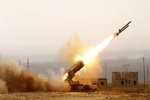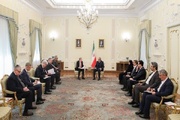Because of some factors such as population growth, need in foodstuff, promotion of products productivity, economization of production, and achievement of self-sufficiency, the necessity of putting the traditional agriculture aside and moving toward the modern and mechanized one has been felt since several years ago.
Furthermore, 37 million hectares of fertile lands and 2.5 million farmers encourage modernization of agriculture.
However, the agriculture sector is slowly supplied with modern machinery and tools although it is using dilapidated machines at different stages of planting, caring and harvesting, leading to poor quantity and quality of agricultural crops.
The farmers, who are keen to use modern machinery such as tractors and combines, face problems due to their high prices as well as great variety and usages. In the Third Development Plan (2000-2005), 70,000 out of 130,000 needed tractors were handed over to the agriculture sector.
In addition, 60 percent of the tractors and 47 percent of the combines are over 13 years old.
The abovementioned issues are signs of underdeveloped and non-mechanized agricultural mechanism.
Reasons of underdevelopment
Although different measures have been taken to develop the agricultural mechanism in the past years, the realities indicate the inconformity between supply and demand and other shortages.
Engineer Sabbagh Torkan, head of
“The farmers have also faced problems for enjoying banking facilities. These factors prevent the agriculture sector from purchasing machinery.”
He believes structural and infrastructure problems of the agricultural machinery are among the factors, which limit the access to state-of-the-art technology.
Rural areas are suffering from low-level technical knowledge on maintenance and repair of modern agricultural machinery.
In addition,
Mohammad Baqer Marandi, a
Based on the calculations, the average owned lands’ area is 6-7 ha and each farmer owns five parcels. Since the majority of them are living under the poverty line, they use the cheapest agricultural tools and machinery.
Shifting to quick dilapidation of agricultural machinery, he stated, “In our country, one tractor is used for each 145 ha of land. Thus, 20 users reach an agreement to use one tractor in the farming season. But in the developed countries like
Noting that about 7-8 million ha of the farmlands are under cultivation of grains out of which 5 million ha are harvested by using combines and the rest are traditionally harvested, Marandi said that 5,000 combines working in the agriculture sector. One combine is used for each 1,000 ha on average. The average life of a combine is 2,500 hours. In fact, a brand new combine works for 1,500 hours after one year and it is worn-out due to overuse.
According to world standards, a combine’s operation should not exceed 250-300 hours per year if it is to work for eight years.
He criticized educational weaknesses in universities and users’ unscientific approach, saying many of farmers do not believe agricultural machinery experts and refuses to consult with them.
Dr. Seyyed Ahmad Tabatabaii-Far, an agricultural expert talking about educational weaknesses said investment in the universities’ research sector is insufficient and there are not enough tools for practically training the students.
Therefore, he added, the university students are not involved properly in research activities.
Furthermore, the students have lost their motives due to unemployment problem.
According to statistical evidences, two to four students are engaged in manufacturing agricultural machinery and the rest are hired in administrative jobs.
Speaking about farmers’ difficult access to tractors and combines, he said, “Today, Iran is now producing tractors and combines, somehow meeting domestic needs, but the farmers are not provided easily and that is the problem.
“For example, a farmer in Golestan province has deposited sum of money into the account of a factory to buy a combine, but he has not received it after one year because the bank’s facilities share has finished. So, the farmer should wait until that the bank is allocated again. The plans should be outlines in a way a farmer receives his requirements whenever he wishes.”
Tabatabaii-Far believes the process causes the farmers losses, allowing the some to encourage discrimination and bribery.
He referred to improper use of machines as one of the obstacles in the way of mechanized agriculture.
Mohammad Abolfathi, the chairman of the Agricultural Jihad Ministry’s Office for Developing Mechanization, said the low production of the agricultural machinery limits the farmers’ needs, noting that there is not any specific problem for the tractor-mounted implements.
However, the sector is suffering from shortage of heavy machinery. Since they are not manufactured inside the country, some were imported in the previous years, which cannot meet the sector’s need.
He noted mechanized agriculture’s status is yet to be determined in the country and the required investment has not been made in this field as it depends on the government’s macro policies.
Some tractor and combine manufacturing factories fail to provide the farmers on time and the delay inflicts great damages on them.
Pirne’mati, a marketing expert, said the government’s late allocation of subsidies is the main reason behind the delay in deliverance of tractors.
He noted mechanized agriculture’s status is yet to be determined in the country and the required investment has not been made in this field as it depends on the government’s macro policies.
Some tractor and combine manufacturing factories fail to provide the farmers on time and the delay inflicts great damages on them.
Pirne’mati, a marketing expert, said the government’s late allocation of subsidies is the main reason behind the delay in deliverance of tractors.
The unplanned yearlong purchase of tractors is low in the early months of the year. Sometimes there is no purchase due to lack of agreement and understanding between the banks and the city and provincial rationing by the AJM, but in the closing months, the products are sold more than the monthly production. This process causes the agricultural machines to be spared from farmers at the proper time.
Engineer Marandi believes that the after-sales services are not good, and this problem cannot be resolved by supervision, laws or bylaws only.
He says that the factories have purchased their productions without paying attention to their ten-year commitments in regard of providing the spare parts, and it has brought about numerous complaints to the
“Certain producers do not live up to their commitments even during the guarantee period, because they know that there is no competition in this arena. However, this process will be changed and replaced by a new process established in the
Meanwhile,
Hussein Salehi, the managing director of Sirjan Tractor Manufacturing Co. says that according to the law, every producer is tasked to consider 10 percent of the spare parts for production, while no subsidy is allocated to the imported parts, which prevents rendering the limited after-sales services.
According to the experts, the correct planning is prerequisite to render proper after-sales services, and the farmers should have no concern about providing the parts, and every manufacturing unit is charged to provide the costumers with the spare parts at the proper price and within 10 years.
The issue of offering after-sales services is also true about the imported tractors. Given purchase of 1500 heavy-duty tractors with 150 hp from France, England, and Finland, and that 100 combine harvesters and 500 heavy-duty tractors are predicted to be imported this year, there is still question on supplying the spare parts of these machines.
In this regard, Engineer Torkan notes, “In our country, the after-sales services have many problems. Although the urban consumers cannot receive suitable services from the sellers, they have fewer problems than the farmers. Thus, the mechanization center has tasked the contracted foreign manufacturing companies to render proper services.”
To purchase the agricultural machinery, the farmers need bank loans, and Bank Keshavarzi offers these loans against security for property. Since, most of the farmers do not have the security for property suitable to the required credits, thus, the bank accepts the agricultural machines as the security on the condition of obtaining the license plate. For this purpose and in order to keep the agricultural machines, obtaining license plate for the machines was approved by the cabinet in 1995.
In 2003, Law Enforcement Forces deputy for traffic affairs embarked on preparing the required software to issue the license plates for agricultural machinery, and based on the ratifications of the Interior Ministry’s Supreme Council for Traffic, the agricultural machines were expected to receive plates since early 2004, but no measure has been taken in this regard, and the responsible organizations have given no explanation for it.
Torkan said, “In the recent years, the traffic deputy called for the Ministry of Industries and Mines to issue approval for the manufacturing units as well as the units importing the agricultural machines and has set this approval as the precondition for issuing plates. It seems that the precondition has created a difficult scenario in the process.”
Since the world economic conditions and standards are different from those of
Speaking about issuing the approval, Engineer Nosrati, expert for auto and engineering services in Industries Ministry said that the traffic deputy has called on this ministry to issue the technical approval for the agricultural machines, which consists of taking the approval of these machines from Karaj arable centers on their signature as well as the safety certificate of EEC according to the European standards. However, due to the problems of the country’s tractor and combine harvester manufacturing companies, which are impossible to be resolved at the current conditions, the safety standards of the parent factories are presently taken for their products instead of the EEC certificate in order that these factories have the opportunity of adopting their technologies with the world standards.
Commenting on the conditions of the imported products, Nosrati noted, “In order to use the high-quality agricultural machines, the imported tractors and combine harvesters should be approved by the Department of the Environment, thus we have set difficult conditions on these machines.”
According to the experts of the Department of the Environment, issuing the approval for domestically manufactured agricultural machines, like other passenger cars, is subject to presenting a document indicating the observation of environment protection standard’s rules and regulations. For the imported machines, the documents such as the Euro2 standard certificate are required.
According to the experts, domestically manufactured agricultural machines are not of desirable quality, because the technology of certain factories is old and it has not been updated in accordance with the time and state-of-the-art technologies.
Engineer Marandi says that certain tractor and combine manufacturing factories date back to time before the Islamic Revolution, having a technology of the past three decades during which great developments have been made in manufacturing the agricultural machines. These factories have failed to employ better technologies either because of being a governmental institution or lacking production level.
“Results of Karaj Test on the products of these factories indicate that the output of the tractors is lower than the global standards and that they consume much fuel”, he added.
Another expert, Dr. Tabatabaiifar believes that the quality of the agricultural machines is not because of the costliness of the parts, and if the quality is increased, the price of the products will naturally soar.
At the same time, he complained about ignoring the technical principles in the productive units, considering it as a result of the culture of work of the workers, which influences the management and production quality.
Engineer Abolfathi says that the agricultural tools relatively have the acceptable quality; however, some of the agricultural machines are not comparable with the foreign ones, and do not possess the good outcome as far as the increase in efficiency of producing crops is concerned. For example, combine harvesters manufactured domestically are not suitable for the high-yielding farms with over 7-8 tons output.






















Your Comment